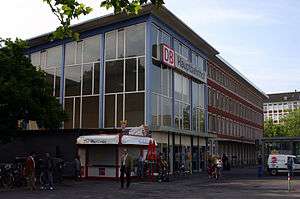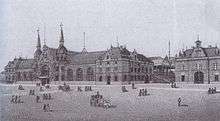Münster Hauptbahnhof
| Crossing station | |
 Station hall seen from street | |
| Location |
Berliner Platz 8-10, Münster, North Rhine-Westphalia Germany |
| Coordinates | 51°57′24″N 7°38′6″E / 51.95667°N 7.63500°ECoordinates: 51°57′24″N 7°38′6″E / 51.95667°N 7.63500°E |
| Line(s) |
|
| Platforms | 9 (1 closed) |
| Construction | |
| Architect |
|
| Architectural style |
|
| Other information | |
| Station code | 4280[1] |
| DS100 code | EMST[2] |
| IBNR | 8000263 |
| Category | 2[1] |
| Website | www.bahnhof.de |
| History | |
| Opened | 1 October 1890 |
| Key dates | |
| 1930 | renovated |
| 1945 | destroyed |
| 1958 | rebuilt |
| Traffic | |
| Passengers | 65,000 |
Münster Hauptbahnhof is the main railway station in the city of Münster in Germany.
History
The original Münster station was opened in 1848 by the Münster-Hamm Railway Company, when it opened by the Münster–Hamm railway to the then capital of the Prussian Province of Westphalia as a terminus of its branch line from Hamm, where it connected with Cologne-Minden trunk line. The railway was opened with a ceremonial run on 25 May 1848. The station building was erected in front of the Servatii-Tor (gate) between the modern streets of Wolbecker Straße and Albersloher Weg.
About a month after the opening passenger services were added to the freight traffic on the line. However, the new means of transport was not particularly successful in the early years. On average 100 passengers per train were recorded.
1855-1880
In 1855, the Münster-Hamm Railway Company was taken over in 1855 by the Prussian government-funded Royal Westphalian Railway Company (Königlich-Westfälische Eisenbahn, KWE). This led to a shortening of travel times, because through trains now ran from Warburg to Munster.
In 1856 the Münster–Rheine railway was opened. This line connected at Rheine with the Hanoverian Western Railway, connecting Löhne, Rheine and Emden.
The concession for the construction of the railway connection from the Ruhr area and Venlo via Münster to Hamburg was awarded in 1866 to the Cologne-Minden Railway Company (Cöln-Mindener Eisenbahn-Gesellschaft, CME). The Wanne–Munster section of this route was opened in 1870. It was extended to Osnabrück in 1871 /and to Hamburg in 1874. So Munster now had direct access to the German North Sea ports. The CME built its Münster station east of the KWE station. This station was designed as a stopgap, so that a single station could be built for both railways.
In western Münsterland, at the beginning of the 1860s there were efforts to promote the local economy by building a railway link from Münster via Gronau to Enschede. Construction began in June 1872, but the Münster-Enschede railway company ran into financial difficulties in 1874. The KWE therefore took over its management and on 30 September 1875 it opened the line to Enschede. This line used the KWE station.`
1880–1914

After the nationalisation of the railways in 1881, all railways in Münster became part of the Prussian state railways. Already in 1875 the rural municipalities of St. Lamberti and Mauritz had been incorporated into Münster, so it now had planning authority for the station area. In 1885, the financial resources became available to build a central station. The opening of the news station took place on 1 October 1890.
Initially planned as a narrow gauge railway from Münster to Telgte, the line from Münster via Warendorf to Rheda was built as standard gauge. On 8 February 1886, the line between Munster and Warendorf. was opened.
Munster increasingly became a main railway station and the rail network was extended in 1903 over the Münster–Warstein line to Neubeckum and in 1908 over the Baumberge Railway via Coesfeld to Empel-Rees. However, the station did not reach achieve the significance the city sought, mainly because the main line connecting Cologne and the Ruhr with Hanover and Berlin bypassed Munster.
1920–1933

In 1920 the German state railways were incorporated in Deutsche Reichsbahn. The line to Lünen was opened in 1928 and the rail freight bypass was opened in 1930.
Since the traffic volume had increased further at the end of the 1920s, the construction of another station platform was necessary. In 1928/30 the station building was rebuilt as a "gateway to the modern city" and the reconstruction was completed at the end of September 1930 for Katholikentag.
1933–1945
Münster was included in the Blitzzug ("Lightning Train") network. From 6 October 1935, Münster was included on the Cologne–Hamburg route of this network.
The situation changed fundamentally with the start of the Second World War. Discounts for travel were abolished in January 1940 and a reduced timetable was introduced. Further reductions of services followed.
In 1941/42, an underground bunker was built at Münster station for 2,000 people. This was captured in 1945, but without injury.
There were 102 air raids on the Münster rail facilities by Allied bombers. The air attacks on the station area destroyed wagons and locomotives as well as 75 to 80% of the tracks. The station building was completely destroyed.
Since 1945
On 2 April 1945, Allied troops marched into Münster. In late April, the lines to the west were reopened. In the summer of 1945 reconstruction began of tracks and signal boxes. After the repair of damaged bridges in the area of Schleuse Münster, trains could also run to Osnabrück again. Because in the platform area the platforms, stairs and pedestrian tunnels were unusable, they had to be hastily repaired before the commencement of passenger operations.
In 1949, a connection was built to the city’s port railway which allowed the passenger trains of the Westfälische Landes-Eisenbahn (Westphalian State Railway) to approach the station from Lippstadt. For this, the Westfälische Landes-Eisenbahn built a fifth platform on the east side of station, which was used only by its own trains. This platform has been closed since the abandonment of passenger service on the line to Lippstadt in the winter timetable of 1975.[3]
At the beginning of the 1950s, the station was rebuilt in several phases. The station hall was completed in 1958 and work at the station was completed 1960. The plans for the work at the station and adjacent areas were prepared by the Munster-born chief architect of Deutsche Bundesbahn, Theodor Dierksmeier.
From 8 June 1960 in Münster was connected to the Trans Europ Express network. The TEA Parsifal express ran from Hamburg to Paris and stopped in Münster.
In September 1968, the whole line was between the Ruhr and Hamburg was electrified; the line between Münster and the Ruhr had already been electrified for two years. The line was electrified to Emden in 1981.
Starting on July 23, 2012 the private railway company Hamburg-Köln-Express provides up to three intercity train pairs daily along the route Hamburg - Münster - Cologne.[4] The French rail company SNCF is also thinking about a new TGV lines, including a route from Strasbourg to Frankfurt, Cologne and Münster to Hamburg. A realization of these plans could take place in 2011. As of 2014, no further plans have been announced on this TGV route.[5]
Train services
The station is served by the following services:[6]
- Intercity Express services (ICE 91) Hamburg - Bremen - Münster - Dortmund - Essen - Düsseldorf - Cologne - Koblenz - Frankfurt - Nürnberg - Passau - Linz - Vienna
- Eurocity services (EC 30) Hamburg - Bremen - Münster - Dortmund - Essen - Düsseldorf - Cologne - Koblenz - Mainz - Mannheim - Karlsruhe - Basel - Zürich - Chur
- Intercity services (IC 30) Westerland - Hamburg - Bremen - Münster - Dortmund - Essen - Düsseldorf - Cologne - Koblenz - Mainz - Mannheim - Stuttgart
- Eurocity services (EC 32) Münster - Düsseldorf - Cologne - Koblenz - Mainz - Mannheim - Stuttgart – München – Salzburg – Villach – Klagenfurt
- Eurocity services (EC 32) Münster - Düsseldorf - Cologne - Koblenz - Mainz - Mannheim - Stuttgart – Lindau - Innsbruck
- Intercity services (IC 35) Norddeich - Emden - Rheine - Münster - Düsseldorf - Cologne - Koblenz - Mainz - Mannheim - Karlsruhe - Konstanz
- Intercity services (HKX) Hamburg - Osnabrück - Münster - Essen - Düsseldorf - Cologne
- Regional services RE 2 Düsseldorf - Duisburg - Essen - Recklinghausen - Dülmen - Münster
- Regional services RE 7 Rheine - Münster - Hagen - Wuppertal - Cologne - Krefeld
- Regional services RE 15 Emden - Leer - Lingen (Ems) - Rheine - Münster
- Local services RB 42 Essen - Recklinghausen - Wanne-Eikel - Dülmen - Münster
- Local services RB 50 Münster - Lünen - Dortmund
- Local services RB 63 Coesfeld - Münster
- Local services RB 64 Enschede - Gronau - Münster
- Local services RB 65 Rheine - Münster
- Local services RB 66 Osnabrück - Münster
- Local services RB 67 Münster - Gütersloh - Bielefeld
- Local services RB 68 Rheine - Münster
- Local services RB 69 Münster - Hamm - Gütersloh - Bielefeld
- Local services RB 89 Münster - Hamm - Soest - Paderborn - Altenbeken - Warburg
References
- 1 2 "Stationspreisliste 2017" [Station price list 2017] (PDF) (in German). DB Station&Service. 18 November 2016. Retrieved 14 December 2016.
- ↑ Eisenbahnatlas Deutschland (German railway atlas) (2009/2010 ed.). Schweers + Wall. 2009. ISBN 978-3-89494-139-0.
- ↑ Anja Gussek-Revermann, Heinz Kilian: Münster und die Eisenbahn. Ardey-Verlag 2003, p. 173
- ↑ newxtix Hamburg-Köln-Express GmbH gegründet (German)
- ↑ Westfälische Nachrichten vom 3. November 2009 (German)
- ↑ Timetables for Münster Hbf station (German)
External links
- "Münster station information" (in German). Deutsche Bahn. Retrieved 17 September 2011.
- "Münster Hauptbahnhof track plan" (PDF) (in German). Deutsche Bahn. Retrieved 17 September 2011.
- "Münster Hauptbahnhof". NRW Rail Archive (in German). André Joost. Retrieved 17 September 2011.
- "Münster Hauptbahnhof (EMST) area operations". NRW Rail Archive (in German). André Joost. Retrieved 17 September 2011.
| Wikimedia Commons has media related to Münster (Westfalen) Hauptbahnhof. |